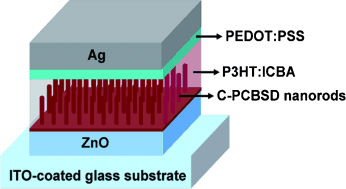Home > Press > Let the Sun Shine in: Nanorods made of fullerenes improve performance of polymer solar cells
 |
Abstract:
The biggest obstacle to making use of solar energy has been the excessively high price of solar cells made of inorganic semiconductors. In contrast, solar cells based on semiconducting polymers are affordable, light, thin, and flexible—but their performance has been lacking. A team led by Chain-Shu Hsu at the National Chaio Tung University and Yuh-Lin Wang at Academia Sinica in Taiwan has now developed a new approach that uses fullerene nanorods to significantly increase the effectiveness of polymer-based solar cells. They introduce their work in the journal Angewandte Chemie.
Let the Sun Shine in: Nanorods made of fullerenes improve performance of polymer solar cells
Germany | Posted on September 15th, 2011In the photoactive layer of a solar cell, light energy sets electrons free. This leaves behind positively charged gaps or "holes". Electrons and holes must be separated quickly and efficiently, or they recombine and reduce the power of the solar cell. The efficiency of a solar cell thus depends on how well the resulting charge is directed away and transported to the electrodes.
In polymer solar cells, it is possible to attain more efficient charge separation through the addition of acceptors, such as fullerenes, which take up electrons. One highly promising concept is to embed the acceptor molecules in a disordered matrix made of photoactive polymer chains. The boundary surface between the two components is thus spread over the entire layer. This construct is known as a "bulk-hetero contact". After charge separation, the electrons and holes are located in different molecular systems, which transport them selectively to opposite electrodes.
The problem is that the two materials are not evenly distributed. The travel pathways for the charges are thus disordered, allowing holes and electrons to encounter each other easily. In addition, charge-separated islands can occur. The solution would be an "ordered bulk-hetero contact", a periodic structure of vertically directed, interpenetrating regions of both materials. Electrons and holes would then have straight pathways that do not cross. However, it has previously not been possible to produce any effective photolayer using this principle, because the components are not molecularly intermixed, making the electron pathways too long to produce effective charge separation.
The Taiwanese researchers decided to combine the two structural principles. By using a nano-casting process, they produced a layer of vertically oriented nanorods from a cross-linking polymeric fullerene material. The spaces between the rods were filled with a mixture made from a photoactive polymer and a fullerene. This layer ensures effective charge separation, and the interpenetration of the fullerene nanorods ensures ordered - and thus effective—charge transport. Solar cells made with this novel combined photolayer are stable and achieve amazingly high performance.
####
For more information, please click here
Copyright © Angewandte Chemie
If you have a comment, please Contact us.Issuers of news releases, not 7th Wave, Inc. or Nanotechnology Now, are solely responsible for the accuracy of the content.
| Related News Press |
News and information
![]() Researchers develop molecular qubits that communicate at telecom frequencies October 3rd, 2025
Researchers develop molecular qubits that communicate at telecom frequencies October 3rd, 2025
![]() Next-generation quantum communication October 3rd, 2025
Next-generation quantum communication October 3rd, 2025
![]() "Nanoreactor" cage uses visible light for catalytic and ultra-selective cross-cycloadditions October 3rd, 2025
"Nanoreactor" cage uses visible light for catalytic and ultra-selective cross-cycloadditions October 3rd, 2025
Announcements
![]() Rice membrane extracts lithium from brines with greater speed, less waste October 3rd, 2025
Rice membrane extracts lithium from brines with greater speed, less waste October 3rd, 2025
![]() Researchers develop molecular qubits that communicate at telecom frequencies October 3rd, 2025
Researchers develop molecular qubits that communicate at telecom frequencies October 3rd, 2025
![]() Next-generation quantum communication October 3rd, 2025
Next-generation quantum communication October 3rd, 2025
![]() "Nanoreactor" cage uses visible light for catalytic and ultra-selective cross-cycloadditions October 3rd, 2025
"Nanoreactor" cage uses visible light for catalytic and ultra-selective cross-cycloadditions October 3rd, 2025
Interviews/Book Reviews/Essays/Reports/Podcasts/Journals/White papers/Posters
![]() Spinel-type sulfide semiconductors to operate the next-generation LEDs and solar cells For solar-cell absorbers and green-LED source October 3rd, 2025
Spinel-type sulfide semiconductors to operate the next-generation LEDs and solar cells For solar-cell absorbers and green-LED source October 3rd, 2025
![]() Rice membrane extracts lithium from brines with greater speed, less waste October 3rd, 2025
Rice membrane extracts lithium from brines with greater speed, less waste October 3rd, 2025
Energy
![]() Sensors innovations for smart lithium-based batteries: advancements, opportunities, and potential challenges August 8th, 2025
Sensors innovations for smart lithium-based batteries: advancements, opportunities, and potential challenges August 8th, 2025
![]() Simple algorithm paired with standard imaging tool could predict failure in lithium metal batteries August 8th, 2025
Simple algorithm paired with standard imaging tool could predict failure in lithium metal batteries August 8th, 2025
Solar/Photovoltaic
![]() Spinel-type sulfide semiconductors to operate the next-generation LEDs and solar cells For solar-cell absorbers and green-LED source October 3rd, 2025
Spinel-type sulfide semiconductors to operate the next-generation LEDs and solar cells For solar-cell absorbers and green-LED source October 3rd, 2025
![]() KAIST researchers introduce new and improved, next-generation perovskite solar cell November 8th, 2024
KAIST researchers introduce new and improved, next-generation perovskite solar cell November 8th, 2024
![]() Groundbreaking precision in single-molecule optoelectronics August 16th, 2024
Groundbreaking precision in single-molecule optoelectronics August 16th, 2024
![]() Development of zinc oxide nanopagoda array photoelectrode: photoelectrochemical water-splitting hydrogen production January 12th, 2024
Development of zinc oxide nanopagoda array photoelectrode: photoelectrochemical water-splitting hydrogen production January 12th, 2024
|
|
||
|
|
||
| The latest news from around the world, FREE | ||
|
|
||
|
|
||
| Premium Products | ||
|
|
||
|
Only the news you want to read!
Learn More |
||
|
|
||
|
Full-service, expert consulting
Learn More |
||
|
|
||








